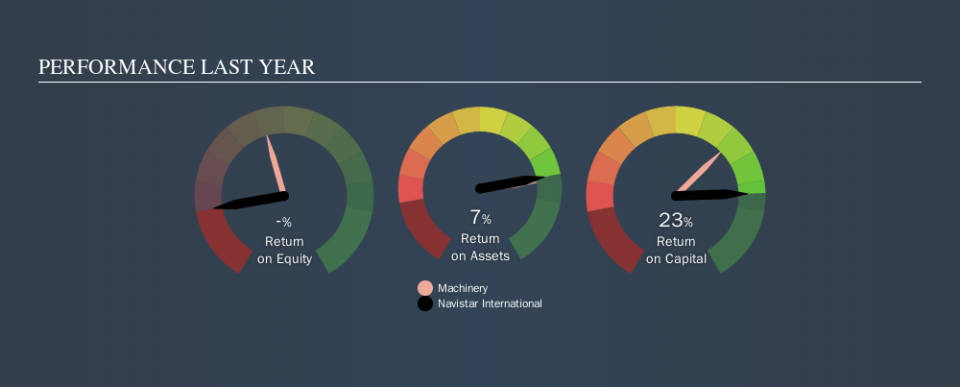Why You Should Like Navistar International Corporation’s (NYSE:NAV) ROCE

Today we are going to look at Navistar International Corporation (NYSE:NAV) to see whether it might be an attractive investment prospect. To be precise, we'll consider its Return On Capital Employed (ROCE), as that will inform our view of the quality of the business.
First up, we'll look at what ROCE is and how we calculate it. Then we'll compare its ROCE to similar companies. Last but not least, we'll look at what impact its current liabilities have on its ROCE.
Return On Capital Employed (ROCE): What is it?
ROCE is a measure of a company's yearly pre-tax profit (its return), relative to the capital employed in the business. Generally speaking a higher ROCE is better. In brief, it is a useful tool, but it is not without drawbacks. Renowned investment researcher Michael Mauboussin has suggested that a high ROCE can indicate that 'one dollar invested in the company generates value of more than one dollar'.
So, How Do We Calculate ROCE?
The formula for calculating the return on capital employed is:
Return on Capital Employed = Earnings Before Interest and Tax (EBIT) ÷ (Total Assets - Current Liabilities)
Or for Navistar International:
0.23 = US$788m ÷ (US$7.3b - US$3.8b) (Based on the trailing twelve months to July 2019.)
Therefore, Navistar International has an ROCE of 23%.
View our latest analysis for Navistar International
Is Navistar International's ROCE Good?
When making comparisons between similar businesses, investors may find ROCE useful. Using our data, we find that Navistar International's ROCE is meaningfully better than the 11% average in the Machinery industry. We would consider this a positive, as it suggests it is using capital more effectively than other similar companies. Setting aside the comparison to its industry for a moment, Navistar International's ROCE in absolute terms currently looks quite high.
We can see that, Navistar International currently has an ROCE of 23% compared to its ROCE 3 years ago, which was 17%. This makes us think the business might be improving. The image below shows how Navistar International's ROCE compares to its industry, and you can click it to see more detail on its past growth.
Remember that this metric is backwards looking - it shows what has happened in the past, and does not accurately predict the future. ROCE can be misleading for companies in cyclical industries, with returns looking impressive during the boom times, but very weak during the busts. ROCE is, after all, simply a snap shot of a single year. Since the future is so important for investors, you should check out our free report on analyst forecasts for Navistar International.
What Are Current Liabilities, And How Do They Affect Navistar International's ROCE?
Liabilities, such as supplier bills and bank overdrafts, are referred to as current liabilities if they need to be paid within 12 months. Due to the way ROCE is calculated, a high level of current liabilities makes a company look as though it has less capital employed, and thus can (sometimes unfairly) boost the ROCE. To check the impact of this, we calculate if a company has high current liabilities relative to its total assets.
Navistar International has total assets of US$7.3b and current liabilities of US$3.8b. Therefore its current liabilities are equivalent to approximately 52% of its total assets. While a high level of current liabilities boosts its ROCE, Navistar International's returns are still very good.
What We Can Learn From Navistar International's ROCE
In my book, this business could be worthy of further research. Navistar International shapes up well under this analysis, but it is far from the only business delivering excellent numbers . You might also want to check this free collection of companies delivering excellent earnings growth.
I will like Navistar International better if I see some big insider buys. While we wait, check out this free list of growing companies with considerable, recent, insider buying.
We aim to bring you long-term focused research analysis driven by fundamental data. Note that our analysis may not factor in the latest price-sensitive company announcements or qualitative material.
If you spot an error that warrants correction, please contact the editor at editorial-team@simplywallst.com. This article by Simply Wall St is general in nature. It does not constitute a recommendation to buy or sell any stock, and does not take account of your objectives, or your financial situation. Simply Wall St has no position in the stocks mentioned. Thank you for reading.

